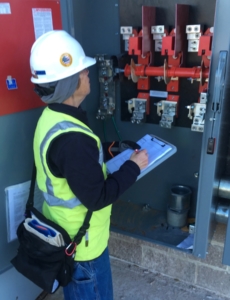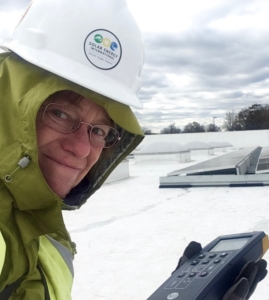SEIPS Team Highlight: Kelly Larson
SEI Professional Services (SEIPS) has a unique and valuable business model in that we employ many of SEI’s instructors and curriculum developers to perform technical work for our clients. Leveraging SEI’s vast network of instructors and subject matter experts across the entire spectrum of solar PV technologies and applications gives our business model a unique edge as compared to other service providers in this space.
One unique aspect to this model is the fact that we consider the thousands of students and alumni that graduate from SEI’s non-profit educational program as future clients – not our competition. With so many new people working in the solar industry we feel it is important to offer our expertise and services to ensure quality work is being performed across the industry. One great example of this model is through the work Kelly Larson, SEI Instructor, does for SEIPS. Kelly has been working in the industry and teaching for SEI for years and is one of the most experienced solar professionals within our network. We had a chance to sit down with Kelly to talk about her work and the impact it is making on our industry.
SEIPS:
Kelly thanks for taking some time to talk with us about your efforts with SEI Professional Services.
Kelly:
Thanks for having me.
SEIPS:
What are some of the most recent projects you have worked on?
Kelly:
Lately I’ve been working on helping hospitals and clinics implement solar in space they have available – usually building’s roofs, and parking lots and structures. Most recently I have been visiting existing facilities to evaluate them for future PV systems. I really enjoy these opportunities to find existing rooftop spaces that are perfect locations for PV systems.
SEIPS:
As you know, SEIPS does a lot of work for past students who have gone through SEI’s training program and partner with us to assist on some of these projects. What are some of the common tasks you do on a job site?
 Kelly:
Kelly:
Some of the common tasks I perform include measuring the space and calculating needed square footage for the desired output. I use tools to assess shading, document areas where installation is not possible due to obstructions, drainage, roof orientation, roof/substructure type and condition, structural strength and such. I pay special attention to landscaping for future shading impact. During this process, I determine where the point of interconnection to the existing electrical service will be, and how that connection can be accomplished, including conduit routing between the PV array and the point of interconnection.
SEIPS:
It sounds like a lot of your work consists of finding creative and effective ways of integrating PV into existing structures. Tell us a little more about the process that goes into that work.
Kelly:
I look at how construction can be accomplished in these busy, often tightly spaced facilities, and make a plan for work, noting areas available for laydown of equipment during construction, and how equipment will be moved to the rooftops. The information I gathered will be used to design the safest, most effective solar installations possible. I enjoy the troubleshooting and puzzle aspect of this work – I see what could be and then figure out how that vision could come to be.
SEIPS:
Tell us about one of your most challenging and favorite projects you have worked on.
Kelly:
One of my favorite projects is this last one – on medical facilities. I find working directly with the customer from the very beginning of the project very fulfulling, and hope to guide the whole process to the completion of well installed, effective systems that the customer is pleased with, and that performs to the highest capability.
SEIPS:
In addition to working for SEIPS you also teach for SEI. Tell us how the concepts and principles you teach in the classroom are also applied in the actual field work you do when it comes to both smaller residential vs. larger commercial and utility scale work.
Kelly:
Designing and installing a small residential system can be fairly simple – if the designer and installer reads the equipment instruction manuals, uses best practices they learn in SEI classes, and coordinates with professionals in their area like an electrician, the permitting folks, and the utility to do the work to the local requirements.
Designing and installing a larger system is more complex. They often include advanced skills. They also regularly require engineering services for plansets and other details. A small detail missed in the beginning of a project can easily wind up costing thousands of dollars and lost work time to find a solution. Employing experts, engineering services can assist those new to solar, (or those new to larger systems), to build these larger systems with confidence and grace.
SEIPS:
Those are all good points to consider. How can SEIPS help past SEI students and alumni with some of these more advanced and engineering services?
Kelly:
It is rare to find experts that know about all aspects of PV systems and who are willing to help those new to solar. This unique combination, and the association SEIPS has with SEI’s non-profit school, serves to help alumni pull off projects they wouldn’t be able to otherwise.
At SEI we strive towards a future where solar is commonplace. The path to that goal includes making solar more affordable, effective, and safe. Systems small and large benefit from such a goal, and the level of attention that SEIPS affords. Quality is important for safety and effectiveness long term, and will enable SEI’s vision of a world powered by renewable energy.
SEIPS:
Thank you Kelly for giving us insight to your work as an instructor as well as a solar professional working for SEIPS.
Kelly:
No problem. I love talking about our work and sharing my knowledge with students and alumni to ensure quality solar integration work is being accomplished all over the world.

